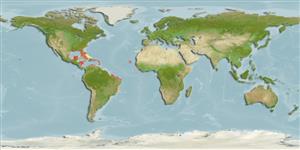Common names from other countries
Classification / Names / Names
Populärnamn | synonymer | Catalog of Fishes (gen., sp.) | ITIS | CoL | WoRMS
Environment: milieu / climate zone / depth range / distribution range
Ekologi
; djupintervall 0 - 25 m (Ref. 2115). Tropical
Western and Central Atlantic: Belize, Cape Verde, Curacao Islands and USA.
Length at first maturity / Size / Vikt / Age
Maturity: Lm ? range ? - ? cm
Lateral processes with tall, slender dorsodistal tubercles, without lateral tubercles. Ocular tubercle with 6 long, slender spines radiating from tip. Abdomen with distal corona of long, slender spines. Chelifore scape second segment with row of similar spines. First coxae with slender anterodistal tubercles and larger posterodistal tubercles, each bearing long, slender spine, lacking on posterior pair of coxae. Major leg segments with several very long spines, the longer ones usually bearing many lateral setules. Femoral cement gland originating in tiny proximo- ventral bulge with slender tube projecting laterally (Ref. 2115, p. 27-28).
Coastal to shelf (Ref. 1951, page 2). Epibiotic (Ref. 116112).
Life cycle and mating behavior
Könsmognad | Reproduktion | Lek | Ägg | Fecundity | Larver
Members of the class Pycnogonida are gonochoric and sexually dimorphic. During copulation, male usually suspends itself beneath the female. Fertilization occurs as the eggs leave the female's ovigers. Males brood the egg masses until they hatch. Life cycle: Eggs hatch into protonymphon larva then to adults.
Arango, C.P. 2002. (Ref. 1951)
IUCN Red List Status (Ref. 130435)
CITES status (Ref. 108899)
Not Evaluated
Not Evaluated
Human uses
| FishSource |
Verktyg
Ytterligare information
Age/SizeTillväxtLength-weightLength-lengthMorfologiLarverAbundans
Internet-källor
Estimates based on models
Preferred temperature
(Ref.
115969): 23.4 - 28.2, mean 27 (based on 585 cells).
Price category
Unknown.
